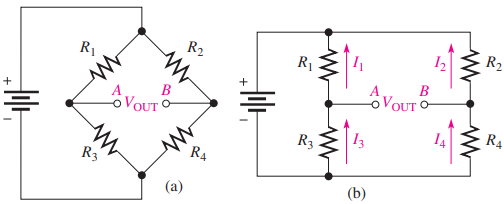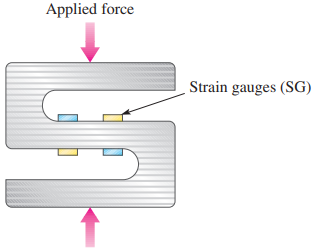Applications of Wheatstone Bridge
The Wheatstone bridge circuit can be used to precisely measure resistance. However, the bridge is most commonly used in conjunction with transducers to measure physical quantities such as strain, temperature, and pressure.
Transducers are devices that sense a change in a physical parameter and convert that change into an electrical quantity such as a change in resistance.
For example, a strain gauge exhibits a change in resistance when it is exposed to mechanical factors such as force, pressure, or displacement. A thermistor exhibits a change in its resistance when it is exposed to a change in temperature.
The Wheatstone bridge can be operated in a balanced or an unbalanced condition. The condition of operation depends on the type of application.

A Wheatstone bridge circuit is shown in its most common diamond-shaped configuration in Figure 1(a). It consists of four resistors and a dc voltage source connected across the top and bottom points of the diamond. The output voltage is taken across the left and right points of the diamond between A and B.
In Figure 1(b), the circuit is drawn in a slightly different way to more clearly show its series-parallel configuration.
The Balanced Wheatstone Bridge
The Wheatstone bridge in Figure 1 is in the balanced bridge condition when the output voltage (Vout) between terminals A and B is equal to zero. When the bridge is balanced, the voltages across R1 and R2 are equal (V1 = V2) and the voltages across R3 and R4 are equal (V3 = V4).
Therefore, the voltage ratios can be written as
V1/V3 = V2/V4
Substituting IR for V by Ohm’s law gives
I1R1/I3R3 = I2R2/I4R4
Since I1 = I3 and I2 = I4, all the current terms cancel, leaving the resistor ratios.
R1/R3 = R2/R4
Solving for results in the following formula:

This formula allows you to find the value of resistor in terms of the other resistor values when the bridge is balanced. You can also find the value of any other resistor in a similar way.
How to Find Unknown Resistance by Wheatstone Bridge
Assume that R1 in Figure 1 has an unknown value, which we call Rx Resistors R2 and R4 have fixed values so that their ratio, R2/R4 also has a fixed value.
Since Rx can be any value, R3 must be adjusted to make in order to create a R1/R3 = R2/R4 balanced condition. Therefore, R3 is a variable resistor, which we will call Rv.
When Rx is placed in the bridge, Rv is adjusted until the bridge is balanced as indicated by a zero output voltage. Then, the unknown resistance is found as

The ratio R2/R4 is the scale factor.
An older type of measuring instrument called a galvanometer can be connected between the output terminals A and B to detect a balanced condition. The galvanometer is essentially a very sensitive ammeter that senses current in either direction. It differs from a regular ammeter in that the midscale point is zero.
In modern instruments, an amplifier connected across the bridge output indicates a balanced condition when its output is 0 V. Also, high precision micro-adjustable resistors can be used in demanding applications. The micro-adjustable resistors enable fine adjustment of the bridge resistors during manufacture for applications such as medical sensors, scales, and precision measurements.
From Equation 2, the value of Rv at balance multiplied by the scale factor R2/R4 is the actual resistance value of Rx. In a practical bridge circuit, the position of the adjustment can be calibrated to indicate the actual value of on a scale or with some other method of display.
Unbalanced Wheatstone Bridge
An unbalanced bridge condition occurs when Vout is not equal to zero. The unbalanced bridge is used to measure several types of physical quantities such as mechanical strain, temperature, or pressure. This can be done by connecting a transducer in one leg of the bridge, as shown in Figure 2.

The resistance of the transducer changes proportionally to the changes in the parameter that it is measuring. If the bridge is balanced at a known point, then the amount of deviation from the balanced condition, as indicated by the output voltage, indicates the amount of change in the parameter being measured. Therefore, the value of the parameter being measured can be determined by the amount that the bridge is unbalanced.
Bridge Circuit for Measuring Temperature
If temperature is to be measured, the transducer can be a thermistor, which is a temperature-sensitive resistor. The thermistor resistance changes in a predictable way as the temperature changes. A change in temperature causes a change in thermistor resistance, which causes a corresponding change in the output voltage of the bridge as it becomes unbalanced.
The output voltage is proportional to the temperature; therefore, either a voltmeter connected across the output can be calibrated to show the temperature or the output voltage can be amplified and converted to digital form to drive a readout display of the temperature.
A bridge circuit used to measure temperature is designed so that it is balanced at a reference temperature and becomes unbalanced at a measured temperature. For example, let’s say the bridge is to be balanced at 25°C. A thermistor will have a known value of resistance at 25°C.
Strain Gauge Applications of Wheatstone Bridge
A Wheatstone bridge with a strain gauge can be used to measure forces. A strain gauge is a device that exhibits a change in resistance when it is compressed or stretched by the application of an external force.
As the resistance of the strain gauge changes, the previously balanced bridge becomes unbalanced. This unbalance causes the output voltage to change from zero, and this change can be measured to determine the amount of strain.
In strain gauges, the resistance change is extremely small. This tiny change unbalances a Wheatstone bridge and can be detected because of its high sensitivity. For example, Wheatstone bridges with strain gauges are commonly used in weight scales.
Some resistive transducers have extremely small resistance changes, and these changes are difficult to measure accurately with a direct measurement. In particular, strain gauges are one of the most useful resistive transducers that convert the stretching or compression of a fine wire into a change in resistance.
When strain causes the wire in the gauge to stretch, the resistance increases a small amount and when it compresses, the resistance of the wire decreases. Strain gauges are used in many types of scales, from those that are used for weighing small parts to those for weighing huge trucks.
Typically, the gauges are mounted on a special block of aluminum that deforms when a weight is on the scale. The strain gauges are extremely delicate and must be mounted properly, so the entire assembly is generally prepared as a single unit called a load cell.
A load cell is a transducer that uses strain gauges to convert mechanical force into an electrical signal. A wide variety of load cells with different shapes and sizes are available from manufacturers depending on the application.

A typical S-shaped load cell for a weighing application that has four strain gauges is illustrated in Figure 3(a). The gauges are mounted so that two of the gauges stretch (tension) when a load is placed on the scale and two of the gauges compress.
Load cells are usually connected to a Wheatstone bridge as shown in Figure 3(b) with strain gauges (SG) in tension (T) and compression (C) in opposite diagonal legs as shown. The output of the bridge is normally digitized and converted to a reading for a display or sent to a computer for processing.

The major advantage of the Wheatstone bridge circuit is that it is capable of accurately measuring very small differences in resistance. The use of four active transducers increases the sensitivity of the measurement and makes the bridge the ideal circuit for instrumentation.
The Wheatstone bridge circuit has the added benefit of compensating for temperature variations and wire resistance of connecting wires that would otherwise contribute to inaccuracies.
In addition to scales, strain gauges are used with Wheatstone bridges in other types of measurements including pressure measurements, displacement and acceleration measurements to name a few.
In pressure measurements, the strain gauges are bonded to a flexible diaphragm that stretches when pressure is applied to the transducer. The amount of flexing is related to the pressure, which again converts to a very small resistance change.